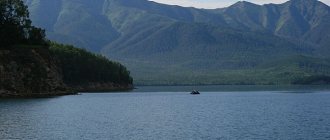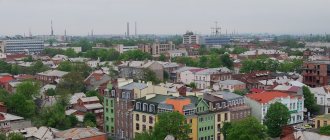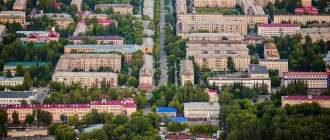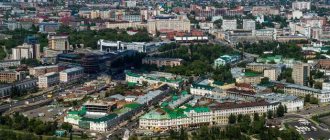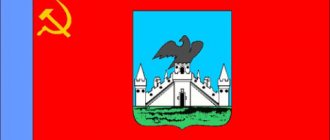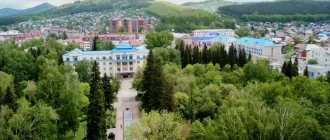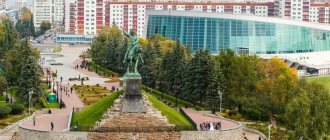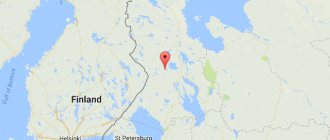General information about the Republic of Ingushetia
Distinctive features . Ingushetia is a small but proud Caucasian republic, which at one time made a lot of noise throughout the Soviet Union, and later on Russia. In terms of area, of all Russian regions, only Moscow and St. Petersburg are smaller than Ingushetia. In addition, it is the youngest republic in the Russian Federation (formed on June 2, 1992).
Ancestral towers against the backdrop of mountain landscapes are the calling card of Ingushetia
Another not entirely pleasant feature of Ingushetia is its extremely low investment rating. In this region, the lowest risk is environmental. And indeed, everything is in order with the environment here, which cannot be said about everything else. How can one not recall the recent war in the Caucasus, invasions of gangs from Georgia, and unresolved territorial issues with North Ossetia and Chechnya. Serious investors are simply afraid to invest their money here - they may not get it back. As a result, it ranks 84th in the ranking of regions by investment risk.
All this has an extremely unfavorable impact on the economy and social sphere. The republic has some of the highest rates of poverty and unemployment in Russia. At the same time, it has the highest birth rate. In general, this is an example of “third world” countries on the territory of the Russian Federation.
Geographical location. Ingushetia is comfortably located on the northern slopes of the Greater Caucasus Range and the small ridges adjacent to it. The republic is part of the North Caucasus Federal District and borders on North Ossetia in the west, the Chechen Republic in the east, and Georgia in the south.
On the map, Ingushetia appears to us as a rectangle with a length from north to south - 144 km, from west to east - 72 km. Despite the small area of the territory, the republic's topography is varied: there are steppe plains in the north and mountain ranges in the south, with picturesque gorges. The main river of Ignushetia is Sunzha, which flows into the Terek, one of the main rivers of the Caucasus.
Gorge of the Assa River - a tributary of the Sunzha
The highest mountain in Ingushetia is Shan (height 4451 m), located on the border with Georgia.
Population. As already mentioned, the birth rate in the republic is very high. In 2012 it was 22.6 people. per 1000 population. And due to the low mortality rate, the natural population increase was 18.9 per 1000 people. At the same time, the population of the republic has remained virtually unchanged since 2001. As of January 1, 2013, it amounted to 442,255 people. This suggests that people are leaving Ingushetia in search of a better life.
Most of the population lives in rural areas. At the same time, the population density is extremely high - 121.9 people. per sq. km. In terms of national composition, Ingush predominate (93.46%), Chechens are in second place (4.55%), and Russians are only in third place (0.78%). The share of the male population is only 44.7%.
The Ingush are one of the Vainakh peoples who form the basis of the population of the North Caucasus. Most of the Ingush are Muslims by religion.
Ingush people love and respect their national dances
Chechens live compactly in the east of the republic, on the border with Chechnya. These are mainly refugees who moved here in the 90s.
To summarize, we note that Ingushetia is a mono-ethnic national republic with a huge number of social problems and very low economic prospects. So it is unlikely that there will be anyone willing to move there from other regions, and if there are, they should think again before taking such a step.
Crime. In the ranking of regions by the number of crimes committed per thousand inhabitants, Ingushetia ranks third from the bottom, second only to Chechnya and Dagestan. It must be said that a low level of crime is typical for most Caucasian regions. This may seem strange. What is the reason for such calm in the republics, which until recently were “hot spots”? The reasons may be different.
On the one hand, the most criminally inclined people from the Caucasian republics are trying to move to large and promising cities in Russia, joining the ranks of national criminal groups. In addition, it should be noted that the leaders of the Caucasian republics are strictly establishing order in their regions. On the other hand, the reason may also be that the official bodies do not want to “wash dirty linen in public” and remain silent about the crimes being committed, preferring to solve all problems without unnecessary noise. In general, there can be many reasons, and most likely, each of them plays a role.
Meanwhile, reports about militants in Ingushetia appear in media feeds every now and then. Just a few years ago, there were frequent cases of them attacking the security agencies of the republic. The fight against militants and illegal armed groups does not subside in the republic to this day.
The unemployment rate in Ingushetia is the highest in the Russian Federation: 47.7%. To be fair, we note that just recently, in 2006, it was 64.86%. But it is too early to talk about any improvement in the situation, especially since in 2012 the number of employed people in various sectors of the economy decreased noticeably.
The average salary in Ingushetia is 17,000 rubles. By the end of 2012, its level also decreased, which indicates a serious crisis in the republic. And so, according to this parameter, Ingushetia looks even more or less respectable against the background of other Caucasian republics, especially Dagestan.
Property value. In Ingushetia, it is not apartments that are often sold, but entire houses, because the majority live in rural areas. A good house can be bought for 2-3 million rubles. As for apartments in Magas and Nazran, one-room apartments cost about a million rubles, two-room apartments - 1.5 - 2 million rubles, three-room apartments - 3 million rubles.
Nazran is the largest city in Ingushetia
The climate of Ingushetia is determined by its location on the ridges of the Caucasus. There are often strong winds here; in mountainous areas, winter comes very early - as early as September. Warm and humid summers are characterized by an average temperature of +7 ... +20°C. In Nazran in July it is slightly warmer than +26°C. In winter, the average temperature is about −7°C. The amount of precipitation depends on the location. On the northern slopes this figure reaches 1000 mm per year, on the southern slopes - only 400 mm per year.
Climate and ecology
The Republic of Ingushetia is located in a zone of favorable high-mountain continental climate. The weather varies depending on the altitude of the area. Steppe territories are characterized by long, warm summers and short, mild winters. In the highlands, winter lasts longer and can be quite severe. The average temperature in winter is around -3...+6 degrees. In summer, the average temperature is from 20 to 30 degrees Celsius. As we can see, the population of Ingushetia lives in very favorable conditions; the nature here is not only beautiful, but also favorable to people.
Since the Caucasus is a fairly old mountain, there is relatively low seismicity here, so the main danger posed by the mountains is avalanches and landslides. The environmental situation in Ingushetia is quite favorable; there are few industrial enterprises here, and therefore there are no large amounts of emissions into the environment. Damage to nature is caused by people, primarily tourists, as well as oil companies. But so far the level of cleanliness of water and air does not cause any particular concern among environmentalists.
Cities of the Republic of Ingushetia
Magas is the capital of the republic. This city was specially founded in 1995, and it received the status of the new capital of the republic in 2000. The population of Magas is very small - only 4,106 people. It is located just 4 km from Nazran, the former capital of Ingushetia. It is difficult to understand the logic of Ruslan Aushev, who planned to move the capital. According to him, this place used to be the capital of Alanya, destroyed by the Mongol-Tatars. Now this tiny town houses the authorities of the republic, as well as one of the buildings of the Ingush University.
Nazran is the largest city in Ingushetia (population: 102,471 people). Founded in 1781, this fortress became one of the most important strongholds of the Russian Empire in the North Caucasus. City status was obtained in 1967. Nazran is the main economic center of the republic. There is a light alloy plant, a concrete plant, a garment factory and a number of other small enterprises. The city leadership is trying to develop its infrastructure, repairing roads and eliminating landfills. So let's hope that the situation in the republic will gradually improve.
Settlement history
People have lived on the territory of Ingushetia since the Paleolithic era. The Ingush are an ancient nation of the Caucasian race. The people were formed from local tribes and numerous ethnic influences. Over many millennia, several significant archaeological cultures existed here. The immediate ancestors of modern Ingush are considered to be representatives of the Koban culture. The tribes living in these territories had several names: dzurdzuketia, sanars, troglodytes. The fertile lands of Ingushetia constantly attracted conquerors, so local peoples had to build fortresses and towers for defense.
But strong neighboring states are gradually pushing the Ingush into the mountains. Only in the 17th century do they manage to return to the plain. At the same time, Islam came to these lands, which gradually became the dominant religion. At the end of the 18th century, Ingushetia became part of the Russian Empire. At the beginning of the 19th century, the Nazran fortress was founded, which was rebuilt by the six largest Ingush families who swore allegiance to the Russian Tsar. In 1860, the Terek Republic was created here, which became the Mountain Republic after 1917. During World War II, the authorities decided to deport the local population due to the growth of gangs. In 1957, the Checheno-Ingush Republic was restored. After the collapse of the USSR, due to difficult processes, the Republic of Ingushetia was formed. At that time, the population of Ingushetia was small, but gradually the people consolidated around their historical territories and began to build their own state.
Economy and standard of living
Ingushetia is a region with an underdeveloped economy; large federal subsidies come here, which ensure the stability of the region. Industry is poorly developed in the republic; it is mainly represented by the mining industry. Most of the population works in agriculture and in the public sector. Today, the number of poor people in Ingushetia is growing, as production is declining. The region has adopted a special program to support 5 thousand disabled people and 28 thousand large families. The Republic of Ingushetia, whose population is experiencing difficulties finding employment, has an unemployment rate of 8.7%, which is significant by Russian standards. It is especially difficult for young people with higher education to find work, since the production sector is stagnating.
Registration plates 06 region
It is best to set aside a couple of days for the registration procedure. On the first day, prepare receipts indicating that you have paid the fees, as well as all the necessary documents. You will have to submit two papers - one application from the previous owner of the car, in which he asks to deregister the vehicle, the other from the new owner - to register the car. You will also need a car purchase agreement with the signatures of the seller and buyer, photocopies of the passports of the previous and new owner and a copy of the vehicle’s passport. IMPORTANT: a special application form must be submitted to the REO of a given region - there must be three special barcode strips on the back of the paper. The device receives data about the vehicle by reading it from these strips - if the vehicle has not been reported stolen, it automatically issues a new registration certificate.
The next day you need to come to the MREO, preferably around nine in the morning. It is imperative that both owners appear - otherwise, you will not be able to register the car. Don't forget your passports. It is also required to have two seals on applications - the inspector and the expert must put their mark. This is where the task gets a little more complicated, since they are never at their work stations. After that, you need to go to the window with the inscription “Wanted” to receive a mark that the car has not been reported for theft. Now all the documents are in order, you can safely submit them for re-registration. IMPORTANT: your documents will not be accepted if one of the owners is not present, or if he does not have a passport. After all the papers have been submitted, you can go about your own business - after all, you will be given a new car passport no earlier than after lunch.
Neighboring regions of the Republic of Ingushetia - region number 06
Republic of North Ossetia - Alania - 15th region
Chechen Republic – 20 and 95 region
Georgia —
Mtskheta-Mtianeti region
Under the leadership of Evkurov
The next president was Yunus-bek Yevkurov. He abandoned the costly inauguration ceremony and instead met with citizens for a conversation, during which he tried to persuade them to cooperate and work together to normalize the situation. The opposition, under pressure from which Zyazikov was removed, supported the new president. However, even after the new head of Ingushetia came to power, the situation continued to worsen.
In 2009, the former vice-president of the republic was killed, and then an attempt was made on the president himself. After this, the bailiff's car was fired upon, killing two adults and injuring a child. In the same year, a terrorist attack was committed in Nazran, which brought new victims: 20 killed and 140 wounded.
Yunus-bek Yevkurov retired early in 2013, but continued to serve as president and was later elected again. He still leads the republic. In general, his work is assessed positively, stabilization of the situation, development of the economy, culture and sports are noted.
After the 1917 Revolution
During the Civil War, Ingushetia supported the Bolsheviks, who promised to resolve the national issue. When in 1919 the territory was occupied by the Armed Forces of the South of Russia, led by General Denikin, who opposed Soviet power, Ingush died in their thousands fighting for Soviet power. A year later, the general's troops lost control of the territory and were forced to retreat to Novorossiysk.
The newly established Soviet government disbanded the Terek region and gave the Chechen and Ingush districts the status of independent territorial entities. But already in November 1920 they became part of the Mountain Autonomous Soviet Socialist Republic, liquidated in 1924.

